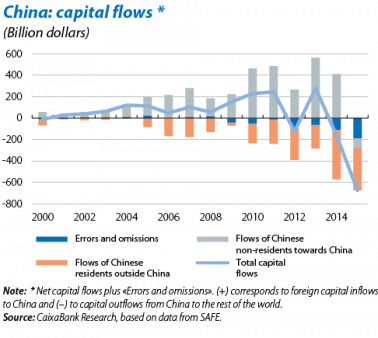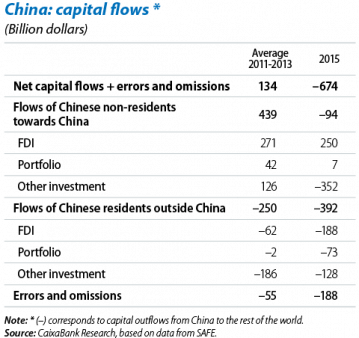China's capital flight, a risk to be taken into account
After years of capital inflows, China suffered a serious episode of outflows between 2014 and 2015 (see the graph). Uncertainty surrounding the possible continuity of capital outflows has been added to growing concerns regarding the true state of the Asian economy. A detailed study of this episode, examining the channels through which the outflows occurred, is vital in order to assess the situation. With this aim in mind, we have analysed China's financial account which measures the flows of capital to and from China, and classify them by investment type (portfolio, direct and other type).
The capital outflows episode studied involved both international investors and especially Chinese residents and have one common denominator: fear of the renminbi (RMB) depreciating even further. International investors concentrated on reducing their offshore deposits in RMB. These deposits are used both for commercial settlements with China as well as for investment and the significant correction in «Other investments» in non-resident flows towards China is partly due to this phenomenon (see the table).1
The increase in capital outflows as a result of decisions taken by Chinese residents was also considerable. There are three channels through which these outflows were carried out. Firstly, numerous Chinese firms paid off their debt in foreign currency. This is also reflected in the «Other investments» of non-resident flows: a large part of this debt had been taken out with local banks which had acquired obligations with foreign banks. This pay-off of debt by companies therefore reduced the loans taken out with non-resident banks (disinvestment).2
The second channel through which resident capital outflows took place is the so-called «over-invoicing of imports», a resource used by Chinese firms to avoid capital controls. This is reflected in the significant rise in «Errors and omissions», which usually includes capital transactions not officially reported. The huge discrepancy between the data reported by the Chinese Customs Agency for imports and bank transactions for commercial purposes, namely 700 billion dollars in 2015, has set off the alarm bells.
Lastly the rise in capital outflows by Chinese residents can also be seen in the sharp increase in investment by Chinese firms in foreign assets (FDI), which is partly due to the doubts they have regarding their economy's growth capacity.
Having examined the nature of the outflows and their reasons, China's capital flight is a risk that must be taken into account. As long as China accomplishes a soft landing and the Fed's interest rate hikes are very gradual, capital outflows are likely to diminish. However, the fact that a very significant proportion of the outflows is due to Chinese firms themselves is not exactly a sign of confidence in their economy's capacity to grow.
1. Although these deposits are not in mainland China, foreign banks with offshore deposits in RMB usually have a correspondent bank in mainland China where they also carry out deposits in the Chinese currency, so a reduction in offshore deposits of international investors entails a drop in onshore deposits of non-resident banks.
2. According to the BIS (Quarterly Review, March 2016), these flows totalled 163 billion dollars up to 2015 Q3.




